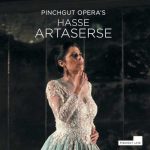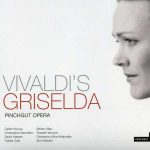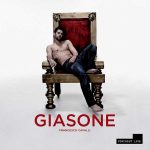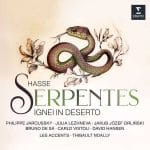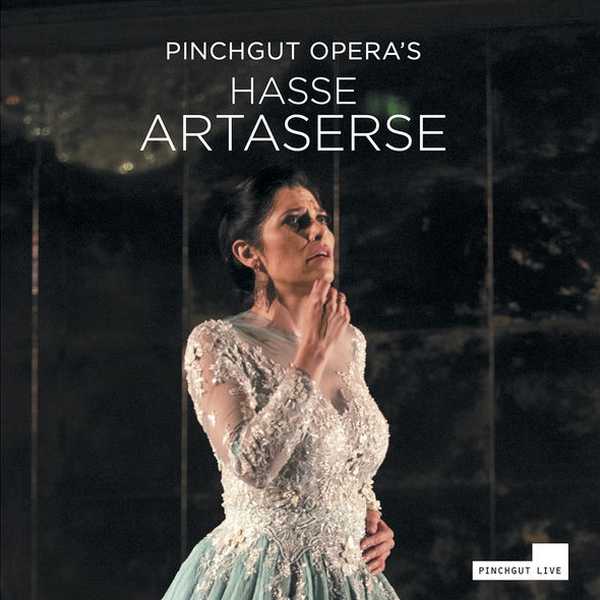
Composer: Johann Adolph Hasse
Performer: David Hansen, Vivica Genaux, Carlo Vistoli, Andrew Goodwin, Russell Harcourt, Emily Edmonds, Pinchgut Opera
Orchestra: Orchestra of the Antipodes
Conductor: Erin Helyard
Number of Discs: 3
Format: FLAC (tracks)
Label: Pinchgut Opera
Catalogue: PG011
Release: 2020
Size: 1.79 GB
Recovery: +3%
Scan: cover
Artaserse
CD 01
01. Sinfonia. Allegro assai – Poco lento
02. Sinfonia. Allegro assai
Act I
Scene 1
03. Addio
04. Conservati fedele
Scene 2
05. O comando! O partenza!
06. Frà cento affanni, e cento palpito
Scene 3
07. Coraggio ò miei pensieri
Scene 4
08. Nò nò, si vada il cenno à rivocar
Scene 5
09. Dove, Principe, dove?
10. Per pietà, bell’idol mio
Scene 6
11. Gran cose io temo
12. Sogna il guerrier le schiere
Scene 7
13. Voi della Persia, voi deità protettrici
14. Bramar di perdere per troppo affetto
Scene 8
15. Dove fuggo? Ove corro?
Scene 9
16. Signore
Scene 10
17. Artaserse respira
Scene 11
18. Arbace è il reo
19. Deh respirar lasciatemi
Scene 12
20. Tu non mi guardi, ò Padre?
21. Non ti son Padre
Scene 13
22. Mà per qual fallo mai
23. Torna innocente
Scene 14
24. E non v’è chi m’uccida?
25. Se al labro mio non credi
CD 02
Scene 15
01. Arbace, Arbace, ah se veder potessi
02. Che pena al mio core
Act II
Scene 1
03. Dal carcere, ò custodi
Scene 2
04. Son quasi in porto
Scene 3
05. I tuoi deboli affetti vinci, Artabano
Scene 4
06. Ahimè che ascolto!
07. Amalo, e se al tuo sguardo
Scene 5
08. Ascolta, ò Megabise
09. Non temer, ch’io mai ti dica
Scene 6
10. Qual serie di sventure
11. Se d’un amor tiranno credei di trionfar
Scene 7
12. A qual di tanti mali prima oppormi
13. Se del fiume altera l’onda tenta uscir
Scene 9
14. Pietà
Scene 10
15. È vana la tua, la mia pietà
Scene 11
16. Tanto in odio alla Persia dunque son’ io
17. Per questo dolce amplesso
Scene 12
18. Ah che al partir d’Arbace
19. Và trà le Selve Ircane, barbaro genitore
CD 03
Scene 15
01. Eccomi al fine in libertà del mio dolor
02. Pallido il sole, torbido il cielo
Act III
Scene 1
03. A funestarti perche vieni
04. Pensa che l’amor mio t’offre la vita
Scene 2
05. Ch’io parta?
06. Parto qual pastorello
Scene 3
07. Figlio, Arbace, ove sei?
08. Spiega i lini, abbandona la sponda
Scene 4
09. Trovaste, avversi Dei, l’unica via
10. Figlio, se più non vivi
Scene 5
11. O che all’uso de’ mali istupidisca il senso
Scene 7
12. Eccola! Oh Dei
13. Tu vuoi ch’io viva, ò cara
14. Sinfonia
Scene 8
15. A voi popoli io m’offro
16. Lucido Dio, per cui l’April fiorisce
Scene 9
17. Al riparo, ò Signor
Scene 10
18. Ferma, ò germano
Scene 11
19. Ecco Arbace, ò Monarca, a’ piedi tuoi
20. Giusto rè, la Persia adora
Based on a libretto by Metastasio already turned into music by more than a hundred composers, this version of Johann Adolph Hasse’s Artaserse comes from the other side of the world. In Sydney, in 2002, Australian conductor and harpsichordist Erin Helyard created the Pinchgut Opera (named after an old prison nearby) and its well-named Orchestra of the Antipodes. The musical ensemble performs operas from the Seventeenth and Eighteenth century. The musicians play with period instruments and their performances could be described as “historically informed.”
In 2019, the orchestra’s production of Hasse’s Artaserse won the International Opera Award in London. It is the first time that particular award was given to an Australian institution. The album is a recording of these performances, an odd opera without any soprano or ensembles, with the exception of a duet and of the final choral piece. Nevertheless, it is still typical of the operas of that time with its long recitatives, its (repeated) aria da capo and a fairly simple plot revolving around conspiracy, betrayal, and light love stories.
Artaserse first opened in 1730 at the Teatro San Giovanni Grisostomo (today, Teatro Malibran) in Venice. The opera was performed by the famous castrato Farinelli, who, at 25 years-old, played the part of Arbace. Artaserse was a huge success. It launched Hasse’s career and made his wife, singer Faustina Bordoni, a Venetian star thus driving Vivaldi, who could feel his popularity getting weaker, to despair. In 1734, the opera was performed in a short and “pasticcio” version at London’s Haymarket where Farinelli, who was performing in London for the first time, sang ten out of the twenty-nine songs. In Sydney, Eran Helyard revives the 1730 version with American mezzo-soprano Vivica Genaux as the star. She is surrounded by a top-notch cast while Eran Helyard conducts with precision and liveliness.
